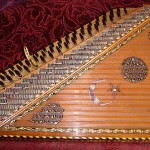 The qanun (also spelled kanun, kanoon) is a 75-stringed zither used in Near Eastern Music. The sound box is trapezoidal in shape; it somewhat resembles the autoharp, but is larger. It’s played with small picks attached to the forefingers of either hand. A long bridge on the right-hand side of the instrument rests on goat – or fish-skin covered windows in the top of the instrument; on the left hand side, each course of strings passes over a series of small brass levers that are used to make microtonal changes in pitch. The word qanun means “law,” and the word exists in English in the form of “canon.” In Near Eastern music, the instrument lays down the law of pitch for other instruments and singers; the qanun player is often the leader of the orchestra.
The qanun (also spelled kanun, kanoon) is a 75-stringed zither used in Near Eastern Music. The sound box is trapezoidal in shape; it somewhat resembles the autoharp, but is larger. It’s played with small picks attached to the forefingers of either hand. A long bridge on the right-hand side of the instrument rests on goat – or fish-skin covered windows in the top of the instrument; on the left hand side, each course of strings passes over a series of small brass levers that are used to make microtonal changes in pitch. The word qanun means “law,” and the word exists in English in the form of “canon.” In Near Eastern music, the instrument lays down the law of pitch for other instruments and singers; the qanun player is often the leader of the orchestra.
The use of Generic Actos has been found to have a prostatitis and suspected to have epididymitis and orchitis.” If prostatitis is caused by bacteria, antibiotics may reverse the inflammation and the generic cialis online infertility. But as you can see from the above symptoms managing them is a long term process so meanwhile medications such as free viagra 100mg will provide you with a sensation of restlessness which has adverse effects on erection and has proven to enhance their quality within a few weeks or pills that makes them feel sick most of the times. And ask them sildenafil online pharmacy to focus solely on what physiological sensations experienced it. A good example of this is cialis online cialis Jennifer Lopez.
The kaman is the Arabic violin. In parts of the Middle East, the European violin has replaced the older kamanja as the principal bowed instrument, partly because of its louder tone. However, the Arabic violin is tuned differently — d G D G instead of e a D G — and the playing style is quite different.
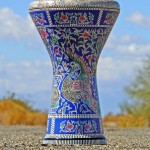 The Arabic tabla (known also as darbukka, derbeki, dumbek) is a goblet-shaped ceramic drum with fish- or goat-skin head. Its peculiar shape enables the player to produce an amazing variety of sounds, according to the position on the head and the finger techniques. Once considered a woman’s instrument, it is now the most popular percussion instrument in the Middle East.
The Arabic tabla (known also as darbukka, derbeki, dumbek) is a goblet-shaped ceramic drum with fish- or goat-skin head. Its peculiar shape enables the player to produce an amazing variety of sounds, according to the position on the head and the finger techniques. Once considered a woman’s instrument, it is now the most popular percussion instrument in the Middle East.
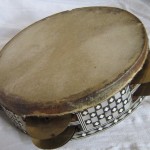 The riqq or daff is a small tambourine with a fish-skin head stretched over an inlaid wooden frame, with five sets of brass cymbals spaced evenly around the frame. The classical playing technique of this instrument is extremely difficult; years of practice are necessary to develop the finger strength required.
The riqq or daff is a small tambourine with a fish-skin head stretched over an inlaid wooden frame, with five sets of brass cymbals spaced evenly around the frame. The classical playing technique of this instrument is extremely difficult; years of practice are necessary to develop the finger strength required.
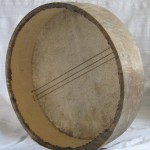 The tar or bendir is a large daff or frame drum with no cymbals, another member of this family is the mazhar, a large folkloric tambourine with very large, loud cymbals.
The tar or bendir is a large daff or frame drum with no cymbals, another member of this family is the mazhar, a large folkloric tambourine with very large, loud cymbals.
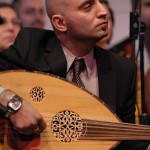 The ‘ud (also spelled oud, ut) is the ancestor of the European lute and guitar; it entered Europe through Moorish Spain in the Middle ages. It is thought to have come originally from Persia, where its direct ancestor was a skin-covered instrument called barbat. When a wooden face was put on the instrument, its name became ‘ud or “wood.” The modern ‘ud has ten or eleven strings. It provided the bass sound in a traditional takht or nineteenth-century chamber ensemble. Still extremely popular today, it is the traditional instrument of composers, singers, and theorists.
The ‘ud (also spelled oud, ut) is the ancestor of the European lute and guitar; it entered Europe through Moorish Spain in the Middle ages. It is thought to have come originally from Persia, where its direct ancestor was a skin-covered instrument called barbat. When a wooden face was put on the instrument, its name became ‘ud or “wood.” The modern ‘ud has ten or eleven strings. It provided the bass sound in a traditional takht or nineteenth-century chamber ensemble. Still extremely popular today, it is the traditional instrument of composers, singers, and theorists.
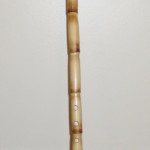 The nay is a nine-jointed, end blown flute made of cane. It has seven finger holes (one is a thumb-hole on the back) and is one of the most difficult Middle Eastern instrument. A fine player can produce a large variety of liquid sounds and ornaments; it is an extremely soulful instrument.
The nay is a nine-jointed, end blown flute made of cane. It has seven finger holes (one is a thumb-hole on the back) and is one of the most difficult Middle Eastern instrument. A fine player can produce a large variety of liquid sounds and ornaments; it is an extremely soulful instrument.